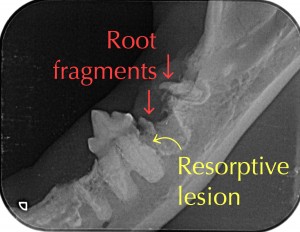You are probably visiting this page because your kitty cat needs dentistry. This is an explanation of why that is and what to expect.
Dental Disease In Cats
Diseases of the teeth and gums in cats are both similar to and very different from what we experience as humans. We are similar in both suffering from periodontal disease. This is the progressive loss of attachment of teeth, causing gum recession, bone loss and eventually root infection and loosening.
Periodontal disease can be stopped by frequent dental cleaning under anaesthetic. By doing this, many cats will never need to experience the pain of bad teeth. Periodontal disease is easy to see, and is the most common reason that we ask for cats like yours to be booked in.

However, there is a second very common oral disease of cats that we often cannot see. This is resorption, which can occur above or below the gumline. The picture shows a typical X-ray of root resorption, where the crown (the visible part) looks completely normal. This same cat also had other hidden problems.
Importantly, this cat was booked in for a ‘routine’ scale and polish for periodontal disease. Only after taking X-rays did we realise that the situation was a lot worse. This is bad news for us, as we only have so much time in the day, and bad news for you, because your kitty will lose some teeth and the bill will be higher.
Since we started using dental X-rays in 2015, we realised just how much we had been missing. This is why we now include 4 standard x-ray views in every feline dental clean.
Cats today are definitely getting much better care, but cat owners sometimes struggle with the fact that their cat was booked in for a simple procedure and only under anaesthetic do we discover painful teeth that need removing. Some other owners cannot understand how the price they were quoted could double once we start the procedure. This probably happens in around one in every four cat dentals.
We hope this message will help you understand if you get the dreaded phone call that we’ve found more than we expected. Trust us when we tell you that we don’t want to find it either, but we equally can’t ignore pain that can be treated. By removing these teeth, we also help your cat eat better and protect the surrounding teeth from spreading infection.
If you have any other questions or concerns about your cat’s treatment, follow-up care, or progress, please do not hesitate to contact the clinic. Thank you for your continued trust in Walkerville Vet. Once your kitty has recovered, visit this page for advice on maintaining dental hygiene at home.
